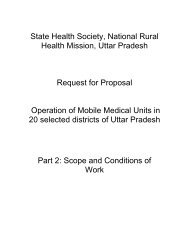Obstetrics Manual for Merrygold Hospitals - State Innovations in ...
Obstetrics Manual for Merrygold Hospitals - State Innovations in ...
Obstetrics Manual for Merrygold Hospitals - State Innovations in ...
Create successful ePaper yourself
Turn your PDF publications into a flip-book with our unique Google optimized e-Paper software.
Risks to the mother and fetus:<br />
I. Maternal risks-hypovolaemic shock, acute renal failure , DIC , PPH{because of<br />
atonic uterus and DIC]<br />
II. Fetal risks-premature delivery {spontaneous and iatrogenic}, fetal anaemia, fetal<br />
distress, IUGR, neurological defects <strong>in</strong> the surviv<strong>in</strong>g <strong>in</strong>fants.<br />
Survival rate depends on severity of abruption, the gestation, birth weight, amount of<br />
concealed haemorrhage.<br />
Assessment and Management:<br />
Assessment<br />
• Blood loss should be assessed [concealed +revealed]: -monitor pulse, blood<br />
pressure, ur<strong>in</strong>ary output [ur<strong>in</strong>ary catheter is required] ,often central venous<br />
pressure.<br />
• Observe <strong>for</strong> evidence of cl<strong>in</strong>ical shock<br />
• Uter<strong>in</strong>e activity, uter<strong>in</strong>e size [may be <strong>in</strong>creas<strong>in</strong>g due to concealed hmg.]<br />
• Coagulation screen , full blood count and cross-match<strong>in</strong>g of a m<strong>in</strong>imum of units<br />
of blood ;urea and electrolytes may also be helpful<br />
• CTG and USG-to confirm viability of the fetus, to exclude pp [pp may be a<br />
co<strong>in</strong>cidental f<strong>in</strong>d<strong>in</strong>g <strong>in</strong> 10% abruptions]. A large retro placental clot may be<br />
identified on USG though it is not a reliable technique.<br />
Management<br />
• Good venous access through 2 large bore <strong>in</strong>travenous canula <strong>for</strong> resuscitation<br />
with blood or plasma expanders. [Avoid use of dextran <strong>for</strong> fear of anaphylactoid<br />
reactions]<br />
• Involve senior obstetricians, hematologists, and anesthetist <strong>in</strong> the management of<br />
the case.<br />
One hour later the maternal condition was essentially unchanged from admission .she still<br />
had a borderl<strong>in</strong>e tachycardia, blood pressure is satisfactory and the uterus cont<strong>in</strong>ues to<br />
contract at 3/10 m<strong>in</strong>. and rema<strong>in</strong>s tender. CTG shows appropriate beat-to-beat variability<br />
with no decelerations <strong>in</strong> response to contractions. Coagulation screen shows a reduced<br />
haemoglob<strong>in</strong>-8.4gm/dl, reduced fibr<strong>in</strong>ogen and <strong>in</strong>creased fibr<strong>in</strong> degradation products,<br />
borderl<strong>in</strong>e prolongation of prothromb<strong>in</strong> time and partial thromboplast<strong>in</strong> time. Platelet<br />
count was still normal.<br />
Further monitor<strong>in</strong>g is required, as serious haemostatic problems could result with the<br />
worsen<strong>in</strong>g of the coagulation screen. The best way to deal with this problem is to effect<br />
delivery to prevent further blood loss and coagulation failure. Blood product therapy,<br />
36










